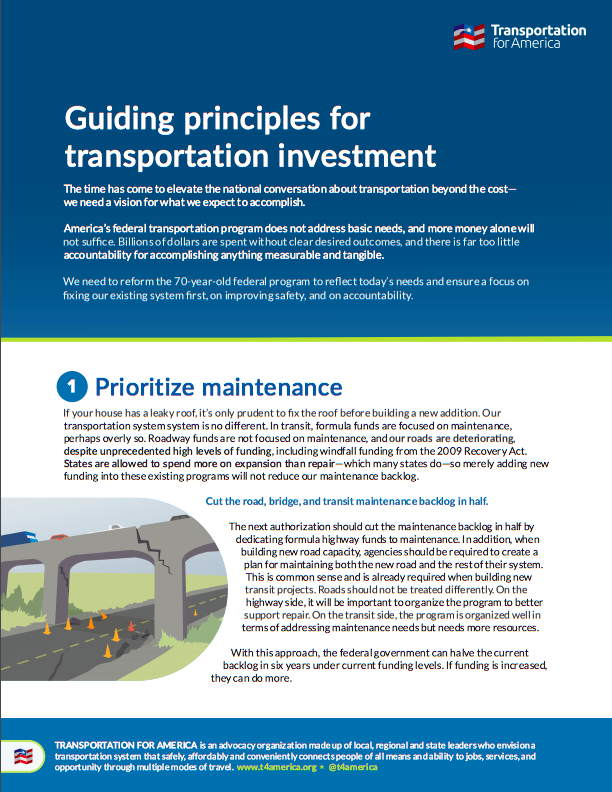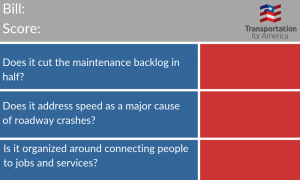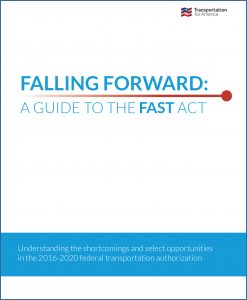Our policy proposals for the upcoming long-term transportation bill
The current federal transportation law expires in September 2020. Reauthorizing this law—a process that comes only once every five years—is an enormous opportunity to change the status quo.
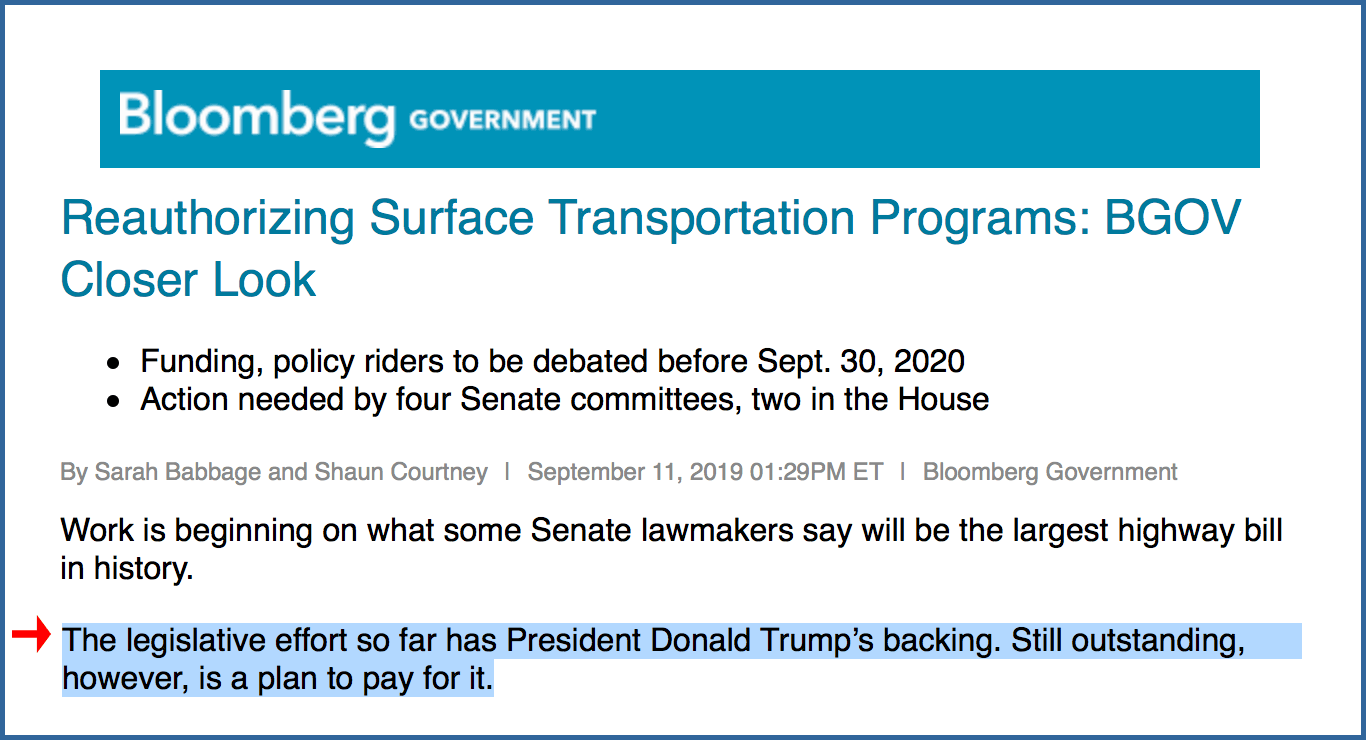 The only conversation that Congress ever wants to have is about money and the overall price tag, and that’s all the media ever asks them about. No one doubts Congress’ ability to spend money, but no one has told the American people what they’ll get after spending $300 billion. It’s past time to talk about policy and set some tangible, concrete goals and re-center the federal transportation program on what really matters to people: getting to where they’re going.
The only conversation that Congress ever wants to have is about money and the overall price tag, and that’s all the media ever asks them about. No one doubts Congress’ ability to spend money, but no one has told the American people what they’ll get after spending $300 billion. It’s past time to talk about policy and set some tangible, concrete goals and re-center the federal transportation program on what really matters to people: getting to where they’re going.
If we’re going to spend more than $50 billion a year, T4America believes it’s time to set some clear priorities with measurable outcomes:
- Fund maintenance, not expansion, in order to cut our maintenance backlog in half
- Establish a culture of designing for safety in order to lower vehicle speeds and making roads safe for all road users
- Measure the success of transportation programs by how well they connect people to jobs and services
Read more about these three principles and their required outcomes
Where we stand on reauthorization for every issue:
Maintenance
For decades, presidents, governors, and members of Congress have decried our crumbling infrastructure with increasingly dire warnings. But they have done almost nothing to actually ensure that the billions we spend every year are directed toward repairing our crumbling infrastructure.
The next reauthorization should—at bare minimum—cut the maintenance backlog in half.
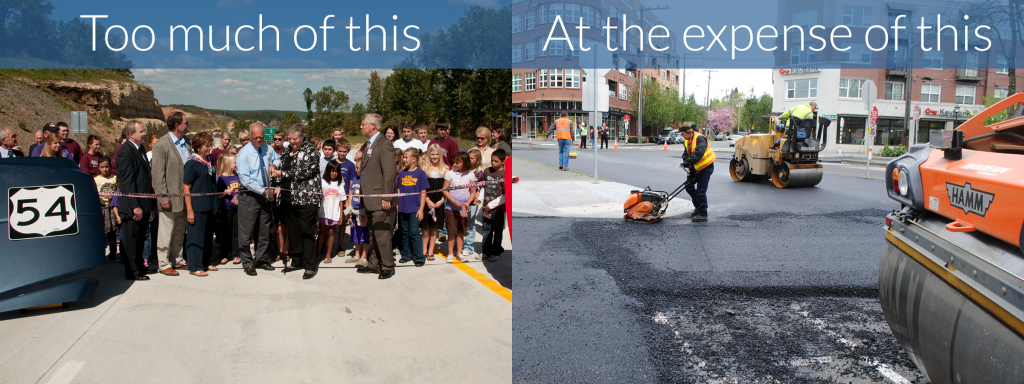
Between 2009 and 2014, states spent $21.3 billion annually to build new roadways and add lanes, while spending $21.4 billion annually repairing the existing road system. Meanwhile the percentage of our roads in poor condition nationwide increased from 14 percent in 2009 to 20 percent in 2018. While most states are putting a greater share of funding toward maintenance than they have in the past, they’re still finding plenty of money to build new roads and expand additional ones while claiming they can’t keep up with their repair needs.
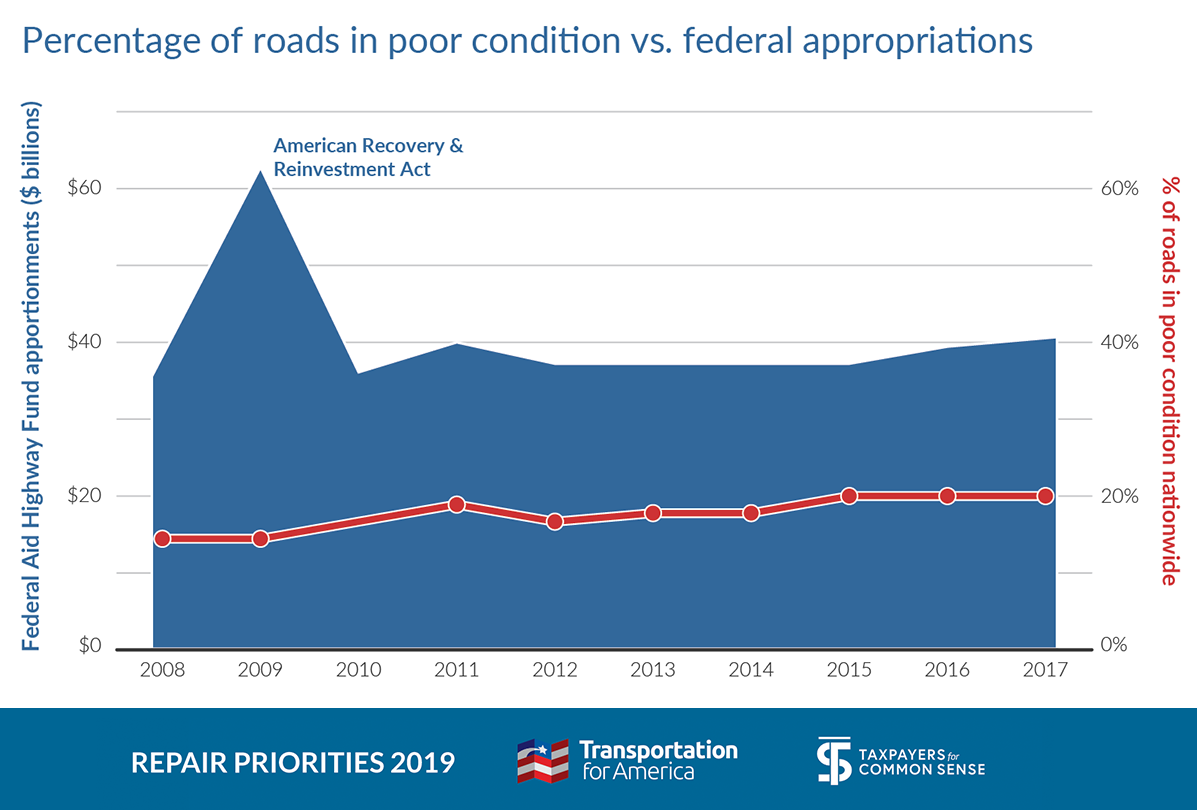
With the Highway Trust Fund approaching insolvency, and our maintenance needs growing, it is time to direct federal investment to care for the system we have before adding expensive new liabilities to it.
Cutting the maintenance backlog in half—without increasing funding—is achievable in six years if we change the structure of the transportation program. We can do this by prioritizing existing highway formula dollars for maintenance; creating a competitive program for new roadway capacity (similar to the transit program) and improving highway performance measures by making them public and rewarding states that hit their targets for asset management.
T4AMERICA’S POLICY PROPOSAL: Prioritize roadway maintenance in surface transportation reauthorization: This short document provides more detail on the three detailed policy recommendations outlined above. (pdf)
How the federal system promotes building new roads at the expense of fixing existing infrastructure: This one-page document explains how federal policy—not a lack of money—is responsible for our crumbling infrastructure. (pdf)
Repair Priorities 2019: T4America’s landmark report assessing whether or not spending priorities line up with the perpetual rhetoric of “repairing our crumbling infrastructure”
Other resources:
- The system is broken (pdf)
Measuring access
Transportation is fundamentally a means for getting people and goods where they need to go—improving access & connectivity. Since the dawn of the modern highway era, we have used the measure of vehicle speed on the road as an incredibly poor proxy for whether or not the system is working. This limited measure has led to building expensive roads and designing communities around achieving high vehicle speed, which often makes access worse by requiring longer trips and making shorter walking or bicycling trips unsafe, unpleasant, or impossible.
The next reauthorization should prioritize the projects that do the most to improve access to jobs and services. USDOT should be required to collect data on how well the transportation system connects people to what they need and create a national assessment of access to jobs and services.
For decades, vehicle speed on a segment of roadway has been used to determine if the entire network is functioning well. If vehicles are moving quickly and smoothly then the system is deemed to be working. If they have to slow or stop, it’s deemed a failure—no matter if the trips are long or short. This measure declares a 30-minute commute at high speed more successful than a 10-minute commute in a little traffic at a slow speed.
Designing roads with speed as the primary consideration has led us to more and wider roads, making traveling outside of a car unsafe and uncomfortable. For example, we might speed up a highway segment by limiting access and removing cross streets. And while some vehicles might now move faster through the corridor, the people who used to have an easy trip on a cross street have a much longer trip and a short walking trip may now even be too long or too dangerous due to the lack of crosswalks and high speeds. All of this forces people to take more and longer car trips, spend more money to get around and emit more pollution.
Today we have much better technology, including GIS and cloud computing, that can allow us to measure the time, speed and convenience of travel by all modes from residential areas to jobs and services. With this information, we can more accurately project trip times, trip lengths, overall travel (measured as vehicle miles traveled), mode split, emissions, health impacts and household transportation expenditure. Measuring accessibility would lead us to a transportation system that prioritizes efficient travel and a more equitable transportation system. We can hold agencies accountable to deliver these connections.
T4AMERICA’S POLICY PROPOSAL: Connect people to destinations in surface transportation reauthorization: This short document outlines our four specific proposals to orient the transportation program around access. (pdf)
Americans want transportation choices: This one-page document breaks down the misconception that Americans are “in love” with cars. (pdf)
Other helpful resources
Transit
Public transportation makes metropolitan economies thrive and is essential to economic opportunity, but the federal system provides too little money, forcing too many potential projects to compete for too few dollars, and only covers half or less of the final cost while subsidizing highways at 80 or 90 percent. Federal policy puts a thumb on the scale making it too hard for local communities to choose a transit solution to a transportation challenge.
The next reauthorization should make transit a priority by funding transit at the same levels as highways, providing a higher federal cost-share for transit projects, and making operating support available. Future federal legislation should make transit safe, reliable, and convenient.
As the Amazon HQ2 search highlighted, companies of all sizes are relocating to walkable and transit-accessible downtown areas to ensure access to a high quality workforce. Transit gives millions of people another option for getting around, and it also supports thousands of manufacturing jobs, in communities small and large, in nearly every state across the country. Ninety-one percent of congressional districts have at least one transit manufacturer and recent capital improvements made in just four transit systems—San Francisco, Denver, Chicago, and Portland—supported jobs in 21 states. A 2015 report found that a 10 percent increase in public transit seats per capita results in wage increases “between $1.5 million and $1.8 billion per metropolitan area”, depending on the size of the region.
But the federal government and transportation policy makes it difficult for communities to build new or expand transit. Over $40 billion is guaranteed to states for highways, which states may spend on expansion even while neglecting their repair needs. By contrast, only $2.6 billion is available for new public transit capital projects, and this funding is not guaranteed each year. While the federal government will cover 80 percent of the cost of a highway project, it will only pay for up to 50 percent of the cost of a transit project.
T4AMERICA’S POLICY PROPOSAL: Make public transportation a priority in surface transportation reauthorization: This short document outlines our six specific proposals to reform the federal transportation program. (pdf)
Transit is a bargain: This one-page document discusses why public transit is an across-the-board great investment. (pdf)
Stuck in the Station: T4America’s project tracking the Federal Transit Administration’s failure to release Congressionally-appropriated transit grants.
Foot Traffic Ahead: Our parent organization’s report on the increasing value of walkable urban places in the 30 largest metro areas in the United States.
Other helpful resources
- Core Values: Why American companies are moving downtown (report by Smart Growth America)
- Americans want transportation choice (pdf)
- How US DOT is slow walking transit grants and why it matters (pdf)
- The system is broken (pdf)
- Transit Supply Chain: How transit supports manufacturing jobs coast to coast
Climate
Transportation is now the single largest source of greenhouse gases (GHG), contributing 29 percent of the United States’ total GHG emissions. While many emissions are decreasing in other sectors, transportation is headed in the wrong direction.
The next reauthorization should require states to measure and reduce their transportation emissions. Reducing vehicle miles traveled is essential to quickly reducing emissions from the transportation sector.
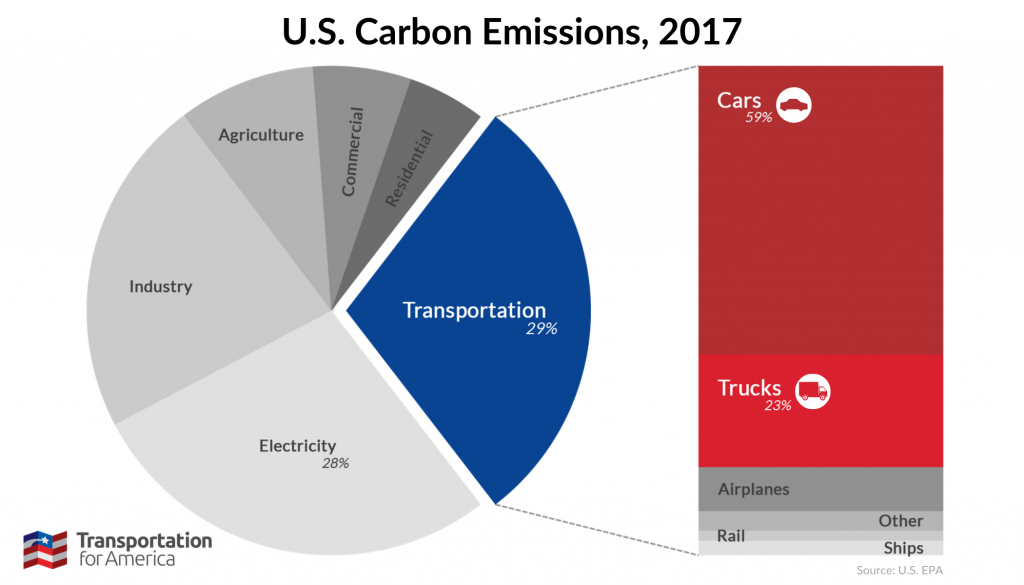
Transportation is the largest sector of emissions and driving represents 83 percent of these emissions. Transportation emissions are rising—despite more efficient vehicles and cleaner fuels—because people are driving more and making longer trips. Transportation emissions are the result of a combination of three things: vehicle efficiency, the carbon content of fuel, and the distance people travel. Gains in two of these areas could be (and have been) negated by losses in the third. For example, Between 1990-2016, despite a sizable 35 percent increase in the overall fuel efficiency of our vehicle fleet, national emissions rose by 21 percent. Why? Because those improvements were accompanied by a 50 percent increase in driving.
Requiring states to set targets to measure and reduce their transportation emissions would give them the flexibility to determine the best strategies for their states, avoiding a one-size-fits-all federal solution.
T4AMERICA’S POLICY PROPOSAL: Make fighting climate change a priority in surface transportation reauthorization: This short document outlines our four specific proposals to reform the federal transportation program. (pdf)
The links between the federal transportation program and climate change: This one-page document discusses how the federal transportation program, in its current state, increases emissions from the transportation sector. (pdf)
To address climate change, we must reduce driving: This infographic explains why electric vehicles and improved fuel efficiency aren’t enough to reduce transportation emissions—we also have to reduce vehicle miles traveled. (pdf)
Other helpful resources
Equity
In transportation, equity means involving people who have been systematically excluded from the transportation planning process and prioritizing projects that serve the needs of those who are most underserved with transportation options or most likely to suffer adverse consequences from the existing system. Because everybody—no matter where they live or who they are—deserves to live in a place that is healthy, prosperous, and resilient.
The current transportation system produces numerous inequities by cutting off low-income communities from safe travel options by different modes of transportation. The next reauthorization should ensure any infrastructure investments are made equitably and that those investments prioritize the safety of all road users and increase transportation options for everyone—especially the most underserved.
Whether through the creation of the interstate system that divided or obliterated neighborhoods or today’s policy of designing local roads for speed over safety, federal transportation policy has and continues to encourage and subsidize investments that exacerbate inequities.
In the past 70 years, the United States has abandoned the only urban development pattern humans have ever known—walkable places—in favor of spread-out, low-density cities and towns where it is not safe, pleasant, or convenient to walk and the only reasonable transportation option is a personal vehicle. Federal transportation policy incentivizes building these types of places by measuring success through vehicle speed—requiring longer and wider roads to achieve high speeds—and by not requiring that states maintain existing roads before building new ones, which encourages building more of these dangerous roads and generating more driving.
These decisions undermine the economic mobility of low-income people and people of color. Due to the growing lack of affordable housing in cities, poverty is becoming more concentrated in suburban locales with incredibly poor access to jobs and services. Around 464,000 low-income people have left gentrifying neighborhoods in the 50 largest U.S. metro areas since 2000, according to one report. The Brookings Institution writes, “On average, residents in low-income suburban neighborhoods that have access to transit can reach just 25 percent of metro area jobs in a 90-minute commute. The share of jobs reachable drops to 4 percent if the commute time is reduced to 45 minutes.”
These communities are suffering significant public health consequences. Air pollution from vehicles particularly harms low-income people of color. The typical arterial road that forms the majority of the street network in these places are the most deadly for people on foot or bike. Drivers strike and kill people over age 50, Black or African American people, American Indian or Alaska Native people, and people walking in communities with lower median household incomes at much higher rates, according to Dangerous by Design, a report by Smart Growth America.
Transportation can and should increase equity: This one-page document discusses how the federal transportation program, in its current state, increases emissions from the transportation sector. (pdf)
Dangerous by Design: A report by Smart Growth America that ranks the most dangerous states, metro areas, and congressional districts for pedestrians.
Other helpful resources
Congestion
Nobody likes being stuck in traffic. We all know the frustration that comes from bumper-to-bumper gridlock, or from watching a traffic light cycle without moving. Though it may not feel like it, congestion is actually sign of economic success: a lot of people want to be in a particular place and will put up with a frustratingly slow ride to get there. It’s a symptom to manage rather than a problem that should be solved—or even can be “solved,” in truth.
Implementing our three principles would prioritize actual solutions to vehicle congestion by preventing states from building new roads that generate more congestion at the expense of regular maintenance; investing to provide more people with other transportation options to take fewer and shorter car trips and making it safe, pleasant, and convenient to use transit, walking, and biking; and by prioritizing access rather than expensive, limited “solutions” for congestion that never solve the underlying problems.
Congestion is caused not by a failure to build enough lanes, but rather by zoning and land use decisions that spread out destinations, combined with an explicit focus on facilitating long distance travel and high vehicle speeds. Building new lanes simply creates more traffic, a concept known as induced demand. A recent study showed that a one percent increase in lane-miles results in a one percent increase in vehicle miles traveled, and any new capacity added fills up in five years or less. There are countless examples in metro areas across the country of an existing major highway or interstate being widened at great expense to taxpayers, only to see traffic increase and then worsen a short time afterward.
Pricing can reduce congestion by lowering the number of vehicles on the road, while funding other infrastructure which will relieve congestion over the long term and most importantly, improve residents’ access to jobs and services.
T4AMERICA’S POLICY PROPOSAL: Connect people to destinations in surface transportation reauthorization: This short document outlines our four specific proposals to orient the transportation program around access. (pdf)
Congestion: how to manage this sign of success: This one-page document explains how our approach to reducing vehicle traffic actually just makes congestion worse. (pdf)
Other helpful resources
Bicyclists and pedestrians
The number of people struck and killed while walking each year have reached levels over the last two years not seen since 1990—even as overall traffic fatalities are falling. In most of the United States, traveling outside of a car is incredibly dangerous, unpleasant, and inconvenient, denying most Americans the healthy and affordable option to bike or walk because their local streets and roads—not just highways—are designed only to move vehicles at the highest speeds possible and not for people walking, biking, or taking transit.
The federal program should require designs and approaches to transportation that prioritize the safety of all road users over vehicle speed.
High speeds make sense on interstates and other limited-access highways, but crashes and fatalities become more likely when those design principles are extended to all other streets. Streets are being designed for high speeds rather than to connect people and create value. Local and arterial roads must be designed with safety as the top priority. Each trip taken on foot or bike is not a trip taken in a car, and encouraging more of these trips should be a stated goal. Even a small shift to walking or biking for trips under a mile would have a dramatic impact on vehicle miles traveled and overall emissions.
A serious effort to reduce deaths on our roadways requires designing for slower speeds in developed areas. The federal program should require designs and approaches to transportation that puts safety first.
Research shows that speeds over 35 mph dramatically increase the likelihood of fatalities in a crash. Non-limited-access roads in towns and cities have lots of points of conflict (driveways, intersections, bicyclists, and pedestrians). At high speeds, these conflicts create significant risks for all, particularly people traveling outside of a car. Protecting the safety of all people who use the street must be a priority reflected in the decisions we make about how to fund, design, operate, maintain, and measure the success of our roads.
T4AMERICA’S POLICY PROPOSAL: Make a safety a priority and design for safety over speed in surface transportation reauthorization: This short document outlines our four specific proposals to make transportation safer. (pdf)
Dangerous by Design: A report by Smart Growth America that ranks the most dangerous states, metro areas, and congressional districts for pedestrians.
Our transportation system is broken: This one-pager explains how federal transportation policy worsens congestion, makes us less safe, and undermines communities. (pdf)
Other helpful resources
New mobility
Over the past few years, smartphone-based or new shared transportation options have started transforming the mobility landscape. While these new services have been heralded as a solution to transportation challenges, every single technological revolution has brought a spate of negative side effects. The data suggests that this revolution could exacerbate congestion, divert riders and revenue from local transit systems, and worsen pre-existing safety hazards that derive from poor curb and road space management.
Federal policy must prioritize safety for all road users, ensure access for people with disabilities, protect local control (avoiding preemption), and provide appropriate data to consumers and local authorities while also equipping the National Highway Traffic Safety Administration (NHTSA) with the resources and authorities it needs to oversee this new technology.
App-based ride-hailing and shared micromobility, like e-scooters, have the potential to improve people’s mobility by providing more options. But we must be realistic about the ability of technology to respond to our respond our problems, and aware of the long history of major technological advances also creating new problems—they are never an unadulterated good.
Transportation for America is a member of a diverse coalition of groups representing vehicle safety, public health, bicyclists, pedestrians, smart growth, consumers, environmentalists, first responders, disability advocates and cities that urged Congress to set policy that enables our country to truly harness the benefits of autonomous vehicles (AVs) while preventing the potential negative impacts on safety, congestion, mobility, pollution, and land use. We sent a letter with detailed policy asks to Congress in August 2019. Read the full letter here.
T4AMERICA’S POLICY PROPOSAL: Promote new, efficient mobility to support national priorities in surface transportation reauthorization: This short document outlines our two specific proposals to guarantee that benefits of new transportation ervices accrue equitably to everyone in our communities. (pdf)
Technology will not save us: This one-page document discusses why new transportation technologies should be treated as tools, not solutions. (pdf)
The Shared Micromobility Playbook: This guide for local officials to create micromobility policy was developed with input from participants in our Smart Cities Collaborative. We are now accepting applications from cities to join the third round of the Collaborative, launching in January 2020.
Other helpful resources
- The system is broken (pdf)
Rail
Amtrak’s national network of long distance and state-supported routes, along with the Northeast Corridor, provide essential transportation connections for local communities. This service is threatened by both a lack of funding and policy which fails to truly support a robust passenger rail system.
The next reauthorization should preserve the existing national and regional passenger networks and improve service by providing meaningful, multi-year capital investment, ensuring on-time service, and expanding access to innovative operating funds with dedicated funding for long-term support.
Our vital rail infrastructure requires significant investment to maintain and expand service. These investments are costly and occur over many years and therefore require stable, sustained, multi-year funding. At the same time, policy makers must create and enforce laws that will enable passenger rail to operate efficiently and to compete for riders across the country.
T4AMERICA’S POLICY PROPOSAL: Maintaining and expanding the national passenger rail system in surface transportation reauthorization: This in-depth document outlines our eight specific proposals to support a robust passenger rail system. (pdf)
Our work for the Southern Rail Commission: T4America helped the Southern Rail Commission, an interstate compact of Alabama, Louisiana, and Mississippi, apply for—and win—over $35 million in federal funding to restore passenger rail to the Gulf Coast.
Other helpful resources





